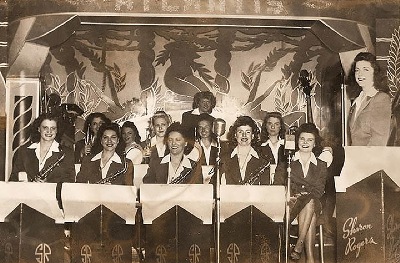
The Sharon Rogers Band, 1940-47
This 12-piece all-female orchestra performed for six months in the Philippines, Japanese and Korean war zones in 1945-46.
In a tour sponsored by the USO-Shows they performed for more than 100,000 troops, visited Hiroshima after the atomic bombing, broadcast on Armed Forces Radio and survived an airplane crash at sea without serious injury.
Photo: The Sharon Rogers band at Coney Island, early 1940s.
From North Chicago to Coney Island and the ‘Foxhole Circuit’
Above all else, members of The Sharon Rogers Band were united in their mission to bring hope, solace and an image of femininity to the troops. They aimed for a sound roughly equivalent to “a Glenn Miller or Harry James” consisting of four saxes, three trumpets, one trombone, piano, bass, drums and a vocalist. There is no surviving audio of the band available.
Emerging from Chicago-area women’s ensembles, the original members of the band were all graduates of Northside Chicago high schools and from a closely-knit community of families. Coalescing as the Melody Maids around 1940 (not to be confused with the 1933 Melody Maids) they were fronted for a while by a male bandleader and business manager, Carl Schreiber.
Getting a gig at the Avalon Ballroom in Chicago they became members of the American Federation of Musicians, Local 10. Before joining the USO, they toured the Midwestern region, once playing opposite Jimmy Dorsey, and were soon gigging across the Eastern half of the United States, garnering wide broadcast exposure on the Blue Radio Network.
Touring widely before 1945 the Sharon Rogers Band took on a vigorous schedule of commercial dance halls, theaters, nightclubs, roller rinks, Stage Door Canteens and radio broadcasts. They also performed one-off shows at army training camps as they segued onto the USO stage.
Their greatest early commercial success was a steady job at the Coney Island Amusement Park in New York City (seen above). That’s where they were approached in late 1944 and recruited to entertain the troops overseas.
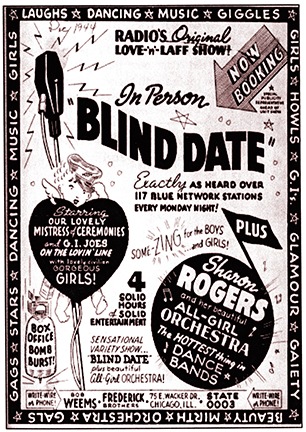
The Sharon Rogers Show and USO Unit #687
In June 1945 they gave a USO-sponsored performance in Brooklyn for a maritime service of 2000 men. It’s probably representative of their USO-approved show.
The program opened with their theme song, “A Pretty Girl is Like a Melody” followed by “Back Beat Boogie” and “Song of the Volga Boatmen.” A vocalist sang “Embraceable You” and “Sentimental Journey” followed by a band novelty, “One Meat Ball.”
Master of ceremonies, Al Zimmey sang “Give my Regards to Broadway” and a couple others. There was also a dance team and baton act with college songs.
Vocalist Jackie Weber was “cute, young and full of life” with “a flair for modern ballads.” Instrumentalists included trumpeter Florence “Flo” Sheffe and Roberta “Bobbie” Taliaffero “played a mean trumpet . . . GIs went wild every time she played” and her specialty was performing “Sugar Blues” in the Clyde McCoy manner.
Trombone player Lois Heise joined the Melody Maids at age 14 and had worked in the USO band of Betty McGuire. Saxophonist Laura Daniels began playing music at age 12 performing in Northwestern Chicago dance bands and was added shortly before the overseas tour. Nicknamed “Gee Jay,” Greta Jean Bogan was an “excellent” drummer.
But, she’d pulled a fast one on the band and Uncle Sam. Bogan was only 16 and had forged her birth certificate. Bandleader Rogers had to do some fast talking to prevent the USO from sending them all home. So indeed, many of these “all-girl” bands often consisted of very young women and girls.

Piano player Shirley Goldberg Moss was considered “a genius” by her band mates. But she fell ill on tour in The Philippines and was replaced by Charlotte Horowitz Murphy. Older and more experienced, “Charlotte would head for the nearest USO and sit at the piano, playing requests that would lead to lengthy sing-along sessions.”
The professional dance team of Rose Marie Scharf and Julieanne Holton joined the troupe in Manila. Holton had started on the USO circuit at age 16. When the show they were traveling with was cancelled in the Philippines they were placed with The Sharon Rogers unit.
The Sharon Rogers Show also offered Variety acts including the married couple of Howard and Wanda Bell: “They were an acrobatic team. He’d stand on a roller on balls. She’d . . . put her head on his and do all kinds of acrobatic moves.”
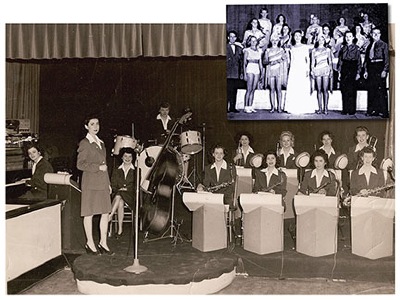
Sharon Rogers
Bass player Sharon “Sherry” Rogers was chosen as leader somewhat arbitrarily, possibly because she stood in front of the band on stage. From there she had eye contact with all the members and was close to the announcing microphone. Or maybe it was her personality and leadership skills.
Tenor saxophonist Laura Daniels told Sherrie Tucker, “She really knew how to handle those men,” meaning certain commissioned officers who acted aggressively or were abusive. In any case, it was a collective decision since the band was run as a co-op.
Photo: Sharon Rogers Band at the Five O’clock Club, Columbia, SC, January 1945. And a photo of the performing troupe. Leader Rogers left, pianist Shirley Goldberg Moss far left. Courtesy Sharon Rogers Wright and from Avery, The Sharon Rogers Band.
The professional dance team of Rose Marie Scharf and Julieanne Holton joined the troupe in Manila. Holton had started on the USO circuit at age 16. When the show they were traveling with was cancelled in the Philippines they were placed with The Sharon Rogers unit.
The Sharon Rogers Show also offered Variety acts including the married couple of Howard and Wanda Bell: “They were an acrobatic team. He’d stand on a roller on balls. She’d . . . put her head on his and do all kinds of acrobatic moves.”
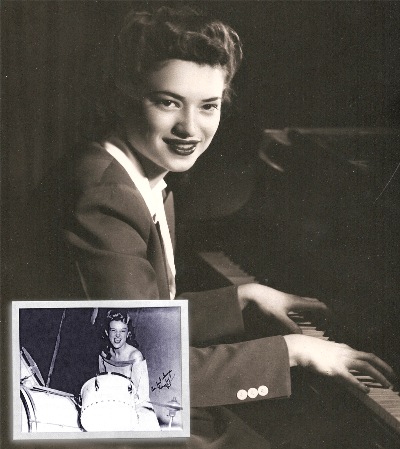
Photo: Pianist Shirley Goldberg Moss in Kalamazoo, MI 1944. Drummer Gee Jay Bogan from Avery, The Sharon Rogers Band.
Touring The Philippines, Japan and Korea
From July 1945 to January 1946, a hectic itinerary took Unit # 687 through The Philippines, Japan and Korea. Starting near Manila they performed at stadiums, hospitals, air fields and Army depots visiting army divisions, the Signal Corps, Field Artillery, Far Eastern Air Service Command, the Engineers and the Seabees. Fighting was still going on: 100,000 died during their stay and the stench of mass graves was unavoidable.
On the Japan-Korea leg of the tour they played 63 shows and two AFRS radio broadcasts in 44 days, while traveling 17 days with only 2 days off. Venues in Japan ranged from a famous opera house to recreation halls, depots and air fields, for a total attendance of 99,400.
In a glowing post-action report Liaison Officer, First Lieutenant Harold W. Peterson commended the performers:
“During the USO Unit #687 tour of Japan and Korea many hardships were encountered such as living conditions, travel facilities, food, climatic conditions and the likes. In one instance we lived on a train for eleven days, using an attached baggage car as our kitchen supplemented with 10-1 rations, but even under these conditions the unit never missed putting on a performance that was scheduled for them, nor was there any dissension or griping . . . "
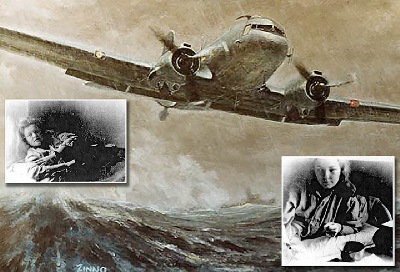
Photo: A painting by Joe Zinno, the C-47 pilot, memorialized the crash. Recuperating in hospital from minor injuries were drummer Gee Jay Bogan (left) and trombonist Lois Heise (right).
Air Crash at Sea and Return Home
On Jan 22, 1946 returning to Japan from Korea, the two-engine C-47 aircraft transporting them hit bad weather and crashed, ‘ditching’ in Shimonoseki Strait just off the Southern tip of Kyushu Island. The water landing was “smooth,” if traumatic. Luckily, they were quickly rescued by local fishermen before the plane sank in twelve minutes.
The musicians took it all in stride as just another chapter in a great adventure worth writing home about, as Laura Daniels did:
“Lois is much better now. Her eye sure got banged up. She was very nervous and suffering from shock for several days. Gee Jay pulled several muscles in her leg and has her knee in splints (however the newspaper exaggerated greatly – nothing broken). The rest of us are fine – which is a miracle when I think of it.”
After a brief hospitalization they returned to America by ship in late-January 1946. For dancers Scharf and Holton, it was their second air crash, yet one of them wrote “I wouldn’t have missed the trip for the world.”
Back in the USA, several in the band wanted to ‘re-up’ and take the ride again. But not all. Soon, The Sharon Rogers Band was unable to compete with returning male musicians, disbanding in February 1947. For a while, Rogers had a combo in Chicago with trumpeter Bobbie Tallieferro and drummer Gee Jay Bogan.
Dancers Holton and Scharf signed up for more overseas duty, touring with the USO shows Hotshot Follies (Germany 1946) and Pardon Me (Philippines 1947). Rose Marie Scharf, a first-generation German-American, departed to entertain troops in Europe on the ocean liner George Washington, the very ship on which her immigrant parents had arrived in America before she was born.
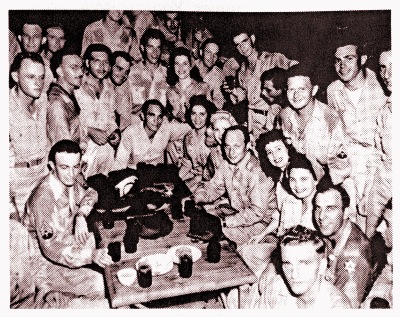
One of the musicians later wrote a song lyric about their experiences set to the melody of “Ragtime Cowboy Joe” and provided the subtitle for Pat Avery’s book:
“They laughed together, cried together, crashed and almost died together
Listen to the rhythm, talk about your rhythm, Sharon Rogers Band!”
LINKS:
Women of Early Jazz, Pt. 1 of 2
https://syncopatedtimes.com/dynamic-women-of-early-jazz-and-classic-blues-pt-1
Women of Early Jazz, Pt. 2 of 2
https://syncopatedtimes.com/dynamic-women-of-early-jazz-and-classic-blues-pt-2
Women of Jazz - five radio programs:
http://www.jazzhotbigstep.com/18801.html
Women of Jazz page
Ada Leonard and the All-American Girl Orchestra
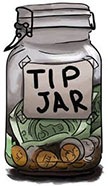
This site is free. But you can help sustain it, and encourage me with donation to the tip jar. Secure payment through PayPal is anonymous, except that I will see your e-mail address.
Donation $5.00
Donation $10.00
Donation $20.00
Donation $35.00
Donation $50.00
Donation: You decide
